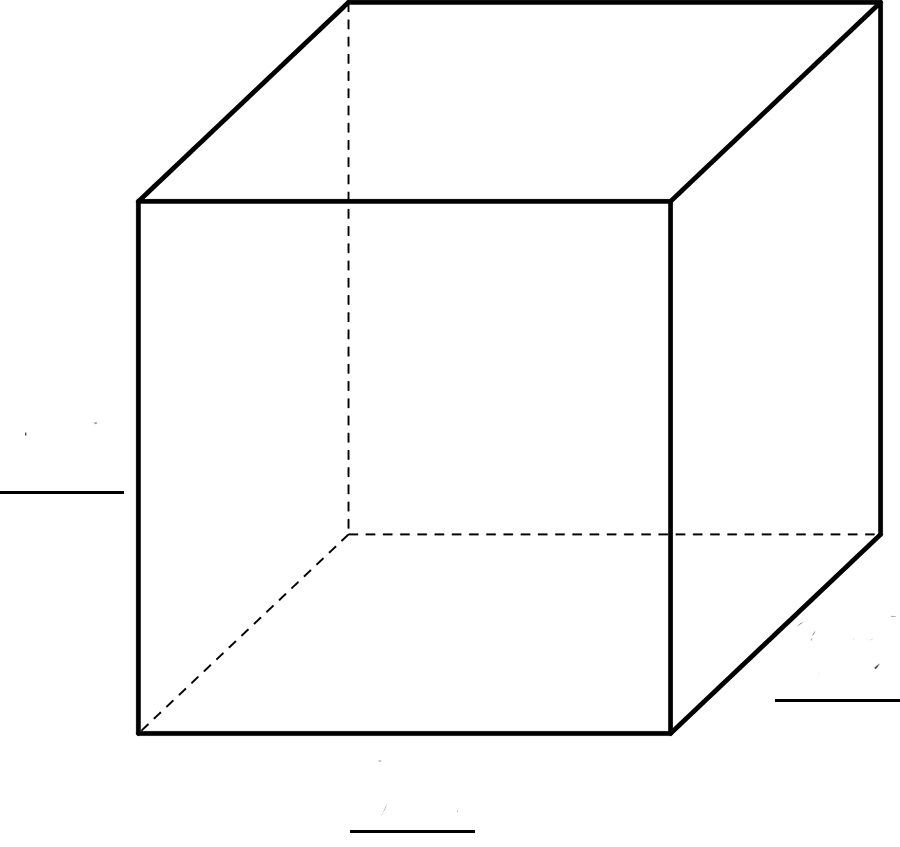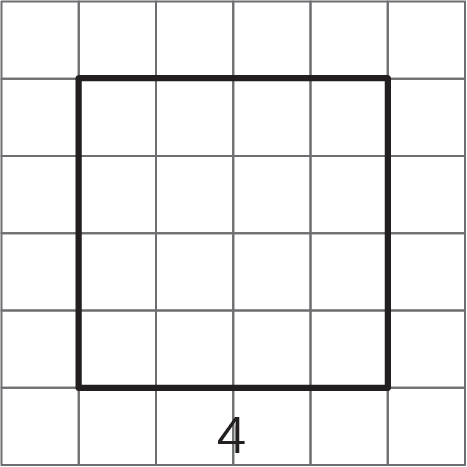Lesson 12
Edge Lengths and Volumes
12.1: Ordering Squares and Cubes (10 minutes)
Warm-up
The purpose of this warm-up is to introduce students to cube roots during the discussion. This activity provides an opportunity to use cube root language and notation during the discussion. Students will explore the possibility of negative cube roots in the next lesson.
At first, students should be able to order the values of \(a\), \(b\), \(c\), and \(f\) without a calculator. However, \(d\) and \(e\) will be easier with a calculator. Encourage students to use estimated values for \(d\) and \(e\) to order the values before using a calculator. As students work, identify students who use different strategies for ordering.
Launch
Students in groups of 2. Give students 2–3 minutes to order the options to the best of their ability without a calculator, and to share their reasoning with a partner. Pause to discuss which are easy to order (likely \(f\), \(b\), \(c\), and \(a\)) and which ones students are not sure about (likely \(d\) and \(e\), which are between \(b\) and \(a\)). Then give students 1 minute with a calculator to finish ordering the options. Follow with a whole-class discussion.
Student Facing
Let \(a\), \(b\), \(c\), \(d\), \(e\), and \(f\) be positive numbers.
Given these equations, arrange \(a\), \(b\), \(c\), \(d\), \(e\), and \(f\) from least to greatest. Explain your reasoning.
-
\(a^2 = 9\)
-
\(b^3 = 8\)
-
\(c^2 = 10\)
-
\(d^3 = 9\)
-
\(e^2 = 8\)
-
\(f^3 = 7\)
Student Response
For access, consult one of our IM Certified Partners.
Activity Synthesis
Ask a student to share their order of \(a\), \(b\), \(c\), \(d\), \(e\), and \(f\) from least to greatest. Record and display their responses for all to see. Ask the class if they agree or disagree. If the class agrees, select previously identified students to share their strategies for ordering the values. If the class is in disagreement, ask students to share their reasoning until an agreement is reached.
As students share, ask students which were the easiest to find and which were the hardest to find. Introduce students to cube root language and notation. Remind students that they previously learned that the equation \(c^2=10\) has solution \(c=\sqrt{10}\). Similarly, we can say that the equation \(d^3=9\) has solution \(d=\sqrt[3]{9}\). Ask students to write the solution to
\(f^3=7\) (\(f=\sqrt[3]{7}\)).
Finally, tell students that while square roots are a way to write the exact value of the side length of a square with a known area, cube roots are a way to write the exact value of the edge length of a cube with a known volume, which students will do in a following activity.
12.2: Name That Edge Length! (10 minutes)
Activity
Now that students have been introduced to the notation for cube roots, the goal of this task is for students to connect their understanding of the relationship between the volume and edge lengths of cubes with that of cube roots.
Launch
Students should not use a calculator, and all values should be exact.
If students are unsure what to put for the “volume equation,” remind them that the volume of a cube is the cube of the edge length.
Supports accessibility for: Social-emotional skills; Conceptual processing
Student Facing
Fill in the missing values using the information provided:

| sides | volume | volume equation |
|---|---|---|
| \(27\,\text{in}^3\) | ||
|
\(\sqrt[3]{5}\) |
||
| \((\sqrt[3]{16})^3=16\) |
Student Response
For access, consult one of our IM Certified Partners.
Student Facing
Are you ready for more?
A cube has a volume of 8 cubic centimeters. A square has the same value for its area as the value for the surface area of the cube. How long is each side of the square?
Student Response
For access, consult one of our IM Certified Partners.
Activity Synthesis
Previously, students learned that knowing the area of a square is sufficient information for stating the exact length of the side of the square using square roots. The purpose of this discussion is for students to make that same connection with the volume of cubes and cube roots. The cube root of the volume of a cube represents the exact value of the edge length of a cube in ways that measuring or approximating by cubing values do not (except in special cases such as perfect cubes).
Discuss:
- “What integers is \(\sqrt[3]{5}\) between?” (\(\sqrt[3]{5}\) is between 1 and 2 because \(1^3 = 1\) and \(2^3 = 8\).)
- “What integers is \(\sqrt[3]{16}\) between?” (\(\sqrt[3]{16}\) is between 2 and 3 because \( 2^3 = 8\) and \(3^3 = 27\).)
- “Name another volume for a cube with edge lengths between 2 and 3.” (A cube with volume 26 has edge lengths between 2 and 3 since since \(3^3=27\), meaning \(\sqrt[3]{26}\) has a value slightly less than 3.)
Design Principle(s): Optimize output (for explanation)
12.3: Card Sort: Rooted in the Number Line (15 minutes)
Activity
The purpose of this activity is for students to use rational approximations of irrational numbers and to match irrational numbers to equations they are solutions to. To do this, students sort cards into sets of three consisting of:
- A square or cube root value
- An equation of the form \(x^2=p\) or \(x^3=p\) that the value is a solution to
- A number line showing the location of the value
Identify groups using clear explanations for how they chose to arrange their sets of 3, particularly when matching the cards with a value plotted on a number line.
Launch
Arrange students in groups of 2–4. Students should not use a calculator for this activity. Tell students that they will be given cards to sort into sets of three. Distribute 27 pre-cut slips from the blackline master to each group. Group work time followed by a whole-class discussion.
Supports accessibility for: Conceptual processing; Organization
Student Facing
Your teacher will give your group a set of cards. For each card with a letter and value, find the two other cards that match. One shows the location on a number line where the value exists, and the other shows an equation that the value satisfies. Be prepared to explain your reasoning.
Student Response
For access, consult one of our IM Certified Partners.
Anticipated Misconceptions
Some students may mix up cube and square roots. Encourage these students to pay close attention to the notation. They may want to fill in the “2” for the square roots similar to how the “3” is used for cube roots.
Activity Synthesis
Select 3–4 previously identified groups to share one of their sets of three cards.
Also discuss:
- “What was a match that was hard to make?” (Two of the number lines have values between 4 and 5, and it took some extra reasoning to figure out that the one with the value closer to 4 was \(\sqrt{18}\) while the one with the point closer to 5 was \(\sqrt[3]{100}\).
- “If another class was going to sort these cards, what is something you would recommend they have or do that you found helpful?” (I would recommend they have a list of perfect squares and perfect cubes to help think about where the different roots are plotted on the number line.)
Design Principle: Maximize meta-awareness
Lesson Synthesis
Lesson Synthesis
In this lesson, students learned about cube roots. Similar to square roots, cube roots can be thought of in the context of shapes; a cube with volume 64 cubic units has an edge length of 4 units, which is \(\sqrt[3]{64}\), because \(4^3 = 64\).
- “If a cube has a volume of 27 cubic inches, what is its side length?” (The cube with volume 27 cubic inches has an edge length of 3 inches, since \(\sqrt[3]{27}=3\).)
- “What is the solution to \(x^3=150\), and what two integers would it fall between on a number line?” (The solution to \(x^3=150\) is \(\sqrt[3]{150}\) and it is between 5 and 6 on a number line, because \(5^3 = 125\) and \(6^3 =216\).)
12.4: Cool-down - Roots of 36 (5 minutes)
Cool-Down
For access, consult one of our IM Certified Partners.
Student Lesson Summary
Student Facing
To review, the side length of the square is the square root of its area. In this diagram, the square has an area of 16 units and a side length of 4 units.
These equations are both true: \(\displaystyle 4^2=16\) \(\displaystyle \sqrt{16}=4\)

Now think about a solid cube. The cube has a volume, and the edge length of the cube is called the cube root of its volume. In this diagram, the cube has a volume of 64 units and an edge length of 4 units:
These equations are both true:
\(\displaystyle 4^3=64\)
\(\displaystyle \sqrt[3]{64}=4\)

\(\sqrt[3]{64}\) is pronounced “The cube root of 64.” Here are some other values of cube roots:
\(\sqrt[3]{8}=2\), because \(2^3=8\)
\(\sqrt[3]{27}=3\), because \(3^3=27\)
\(\sqrt[3]{125}=5\), because \(5^3=125\)